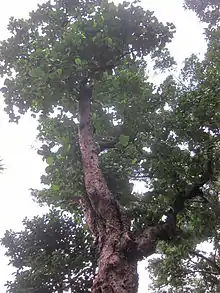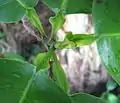Dillenia alata
Dillenia alata, commonly known as red beech or golden guinea tree, is a tropical forest tree in the Dilleniaceae family, found in northern Australia, New Guinea and nearby islands.[3] It is a medium-sized tree with reddish-brown papery bark. The leaves are 11–23 mm long and 6–13 mm wide and connected to the stem by a stem-clasping winged petiole. The five-petalled yellow flowers have a cluster of pink or red styles, anthers and staminoides at the centre.[3]
| Dillenia alata | |
|---|---|
 | |
| Scientific classification | |
| Kingdom: | Plantae |
| Clade: | Tracheophytes |
| Clade: | Angiosperms |
| Clade: | Eudicots |
| Order: | Dilleniales |
| Family: | Dilleniaceae |
| Genus: | Dillenia |
| Species: | D. alata |
| Binomial name | |
| Dillenia alata | |
The species was formally described in 1817 and given the name Wormia alata based on plant material collected by Joseph Banks at Point Lookout, Endeavour River, during Lieutenant James Cook's first voyage of discovery in 1770.[4] The species was transferred to the genus Dillenia by Italian botanist Ugolino Martelli in 1886.[1]
Etymology
The species epithet, alata, means "winged" and refers to the winged leaf-stalks (petioles).[5]
Gallery
 Flower
Flower Fruit and foliage
Fruit and foliage Fruit
Fruit Fruit
Fruit Petioles
Petioles
References
- "Dillenia alata (R.Br. ex DC.) Martelli". Australian Plant Name Index (APNI), IBIS database. Centre for Plant Biodiversity Research, Australian Government. Retrieved 27 August 2013.
- Martelli, U. in Beccari, O. (ed.) (1886) Malesia 3: 157
- Hyland, B. P. M.; Whiffin, T.; Zich, F. A.; et al. (Dec 2010). "Factsheet – Dillenia alata". Australian Tropical Rainforest Plants (6.1, online version RFK 6.1 ed.). Cairns, Australia: Commonwealth Scientific and Industrial Research Organisation (CSIRO), through its Division of Plant Industry; the Centre for Australian National Biodiversity Research; the Australian Tropical Herbarium, James Cook University. Retrieved 27 August 2013.
- "Wormia alata R.Br. ex DC.". Australian Plant Name Index (APNI), IBIS database. Centre for Plant Biodiversity Research, Australian Government. Retrieved 27 August 2013.
- Mabberley, D. (2017) Gooding, M., Mabberley, D., Studholme, J. (eds) Joseph Banks' Florilegium Botanical Treasures from Cook's First Voyage p222, Thames & Hudson, London.
External links
| Wikimedia Commons has media related to Dillenia alata. |